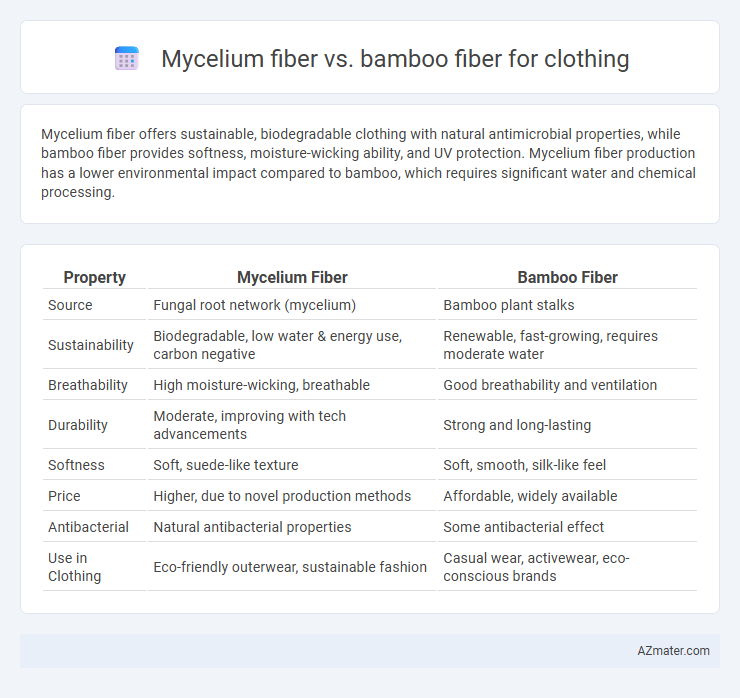Mycelium fiber offers sustainable, biodegradable clothing with natural antimicrobial properties, while bamboo fiber provides softness, moisture-wicking ability, and UV protection. Mycelium fiber production has a lower environmental impact compared to bamboo, which requires significant water and chemical processing.
Table of Comparison
| Property | Mycelium Fiber | Bamboo Fiber |
|---|---|---|
| Source | Fungal root network (mycelium) | Bamboo plant stalks |
| Sustainability | Biodegradable, low water & energy use, carbon negative | Renewable, fast-growing, requires moderate water |
| Breathability | High moisture-wicking, breathable | Good breathability and ventilation |
| Durability | Moderate, improving with tech advancements | Strong and long-lasting |
| Softness | Soft, suede-like texture | Soft, smooth, silk-like feel |
| Price | Higher, due to novel production methods | Affordable, widely available |
| Antibacterial | Natural antibacterial properties | Some antibacterial effect |
| Use in Clothing | Eco-friendly outerwear, sustainable fashion | Casual wear, activewear, eco-conscious brands |
Introduction to Sustainable Textile Alternatives
Mycelium fiber and bamboo fiber represent innovative sustainable textile alternatives gaining attention for eco-friendly clothing production. Mycelium fiber, derived from fungal roots, offers a biodegradable and renewable resource with a low environmental footprint compared to traditional textiles. Bamboo fiber is valued for its rapid growth, natural antibacterial properties, and biodegradability, making it a durable and sustainable choice for reducing reliance on conventional cotton and synthetic fabrics.
What is Mycelium Fiber?
Mycelium fiber, derived from the root structure of fungi, offers a sustainable and biodegradable alternative to traditional textiles, distinguished by its natural antibacterial properties and breathability. Unlike bamboo fiber, which is processed from the pulp of bamboo plants and known for its softness and moisture-wicking ability, mycelium fiber provides excellent durability and a unique, leather-like texture suitable for innovative clothing applications. Advances in biotechnology enable scalable production of mycelium fiber, making it an eco-friendly choice for consumers seeking plant-based, cruelty-free fabrics with minimal environmental impact.
What is Bamboo Fiber?
Bamboo fiber is a natural textile derived from the pulp of bamboo grass, known for its softness, breathability, and antibacterial properties, making it an eco-friendly choice for sustainable clothing. It is biodegradable, moisture-wicking, and offers thermal regulation, which enhances comfort in various climates. Compared to mycelium fiber, bamboo fiber benefits from established manufacturing processes and greater market availability, though mycelium fiber is emerging for its unique fungal origin and regenerative qualities.
Environmental Impact: Mycelium vs Bamboo
Mycelium fiber offers a sustainable alternative to traditional textiles by utilizing fungal root structures that require minimal water, no pesticides, and low energy during production, significantly reducing carbon emissions compared to conventional fibers. Bamboo fiber, while biodegradable and fast-growing, often involves intensive chemical processing that can harm ecosystems and deplete water resources. Choosing mycelium fiber enhances eco-friendly clothing production by minimizing environmental degradation and promoting renewable resource cycles over bamboo's chemically intensive extraction methods.
Production Process Comparison
Mycelium fiber is produced through the cultivation of fungal mycelium, where controlled growth on agricultural waste leads to a biodegradable, leather-like material using minimal water and chemicals. Bamboo fiber production involves mechanical or chemical processing of bamboo pulp, with the mechanical method being eco-friendly but labor-intensive, while chemical processing often uses harsh solvents to create viscose bamboo fiber. Mycelium fiber boasts a low-energy, sustainable production with fewer pollutants compared to bamboo viscose, which raises environmental concerns due to chemical usage and water consumption.
Durability and Longevity
Mycelium fiber exhibits remarkable durability due to its natural resilience and resistance to wear, making it a sustainable choice for long-lasting clothing. Bamboo fiber offers excellent strength and moisture-wicking properties, but may degrade faster than mycelium under intensive use or frequent washing. Both fibers provide eco-friendly alternatives, yet mycelium's cellular structure contributes to superior longevity in textiles compared to bamboo.
Comfort and Wearability
Mycelium fiber offers exceptional breathability and moisture-wicking properties, making it highly comfortable for all-day wear. Bamboo fiber is naturally soft, hypoallergenic, and provides excellent thermal regulation, enhancing comfort in various climates. Both fibers are durable and lightweight, but mycelium's unique cellular structure allows for greater stretch and flexibility, improving wearability during active use.
Biodegradability and End-of-Life
Mycelium fiber and bamboo fiber both offer excellent biodegradability, decomposing naturally within months under composting conditions. Mycelium fiber, derived from fungal mycelium, breaks down faster due to its organic, cellulose-rich structure, promoting minimal environmental impact. Bamboo fiber also biodegrades efficiently but may take longer depending on processing methods and chemical treatments used during fabric production.
Cost and Market Availability
Mycelium fiber offers a sustainable alternative to traditional textiles but remains limited in market availability due to its emerging production technology, resulting in higher costs compared to bamboo fiber. Bamboo fiber is widely accessible and cost-effective, benefiting from established manufacturing processes and large-scale cultivation, making it a popular choice in the clothing industry. Pricing for bamboo fiber ranges typically from $4 to $10 per yard, whereas mycelium fiber can exceed this range due to experimental production and limited commercial scale.
Future Prospects in Eco-Friendly Fashion
Mycelium fiber and bamboo fiber both offer sustainable alternatives to traditional textiles, with mycelium providing rapid growth and biodegradability, and bamboo contributing natural antibacterial properties and moisture-wicking capabilities. Advances in mycelium cultivation technology are expected to lower production costs and enhance fabric durability, positioning it as a revolutionary material in eco-friendly fashion. Bamboo fiber's established supply chains and versatility ensure its continued role in sustainable apparel, while innovations in processing reduce environmental impact, strengthening its future market viability.

Infographic: Mycelium fiber vs Bamboo fiber for Clothing
 azmater.com
azmater.com